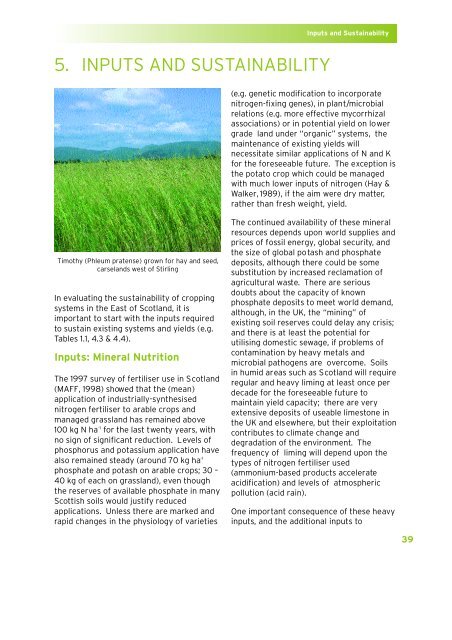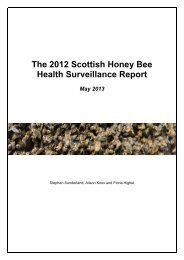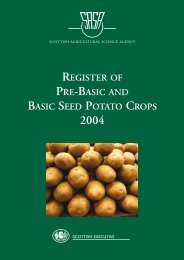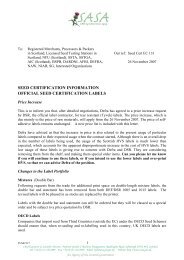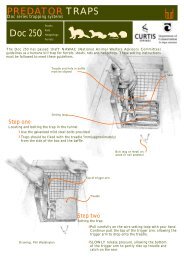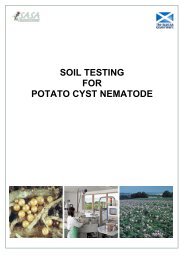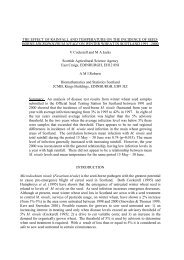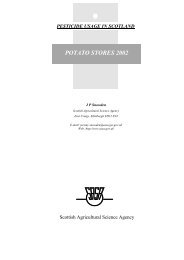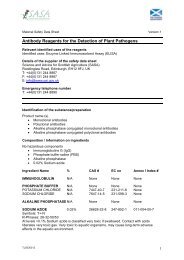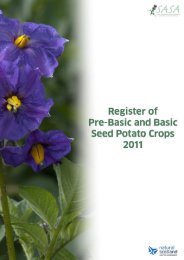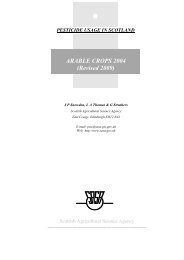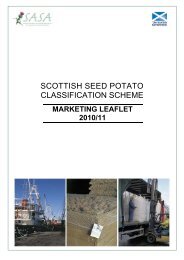Inputs and Susta<strong>in</strong>ability5. INPUTS AND SUSTAINABILITY(e.g. genetic modification to <strong>in</strong>corporatenitrogen-fix<strong>in</strong>g genes), <strong>in</strong> plant/microbialrelations (e.g. more effective mycorrhizalassociations) or <strong>in</strong> potential yield on lowergrade land under “organic” systems, <strong>the</strong>ma<strong>in</strong>tenance <strong>of</strong> exist<strong>in</strong>g yields willnecessitate similar applications <strong>of</strong> N and Kfor <strong>the</strong> foreseeable future. The exception is<strong>the</strong> potato crop which could be managedwith much lower <strong>in</strong>puts <strong>of</strong> nitrogen (Hay &Walker, 1989), if <strong>the</strong> aim were dry matter,ra<strong>the</strong>r than fresh weight, yield.Timothy (Phleum pratense) grown for hay and seed,carselands west <strong>of</strong> Stirl<strong>in</strong>gIn evaluat<strong>in</strong>g <strong>the</strong> susta<strong>in</strong>ability <strong>of</strong> cropp<strong>in</strong>gsystems <strong>in</strong> <strong>the</strong> <strong>East</strong> <strong>of</strong> <strong>Scotland</strong>, it isimportant to start with <strong>the</strong> <strong>in</strong>puts requiredto susta<strong>in</strong> exist<strong>in</strong>g systems and yields (e.g.Tables 1.1, 4.3 & 4.4).Inputs: M<strong>in</strong>eral NutritionThe 1997 survey <strong>of</strong> fertiliser use <strong>in</strong> <strong>Scotland</strong>(MAFF, 1998) showed that <strong>the</strong> (mean)application <strong>of</strong> <strong>in</strong>dustrially-syn<strong>the</strong>sisednitrogen fertiliser to arable crops andmanaged grassland has rema<strong>in</strong>ed above100 kg N ha -1 for <strong>the</strong> last twenty years, withno sign <strong>of</strong> significant reduction. Levels <strong>of</strong>phosphorus and potassium application havealso rema<strong>in</strong>ed steady (around 70 kg ha -1phosphate and potash on arable crops; 30 –40 kg <strong>of</strong> each on grassland), even though<strong>the</strong> reserves <strong>of</strong> available phosphate <strong>in</strong> manyScottish soils would justify reducedapplications. Unless <strong>the</strong>re are marked andrapid changes <strong>in</strong> <strong>the</strong> physiology <strong>of</strong> varietiesThe cont<strong>in</strong>ued availability <strong>of</strong> <strong>the</strong>se m<strong>in</strong>eralresources depends upon world supplies andprices <strong>of</strong> fossil energy, global security, and<strong>the</strong> size <strong>of</strong> global potash and phosphatedeposits, although <strong>the</strong>re could be somesubstitution by <strong>in</strong>creased reclamation <strong>of</strong>agricultural waste. There are seriousdoubts about <strong>the</strong> capacity <strong>of</strong> knownphosphate deposits to meet world demand,although, <strong>in</strong> <strong>the</strong> UK, <strong>the</strong> “m<strong>in</strong><strong>in</strong>g” <strong>of</strong>exist<strong>in</strong>g soil reserves could delay any crisis;and <strong>the</strong>re is at least <strong>the</strong> potential forutilis<strong>in</strong>g domestic sewage, if problems <strong>of</strong>contam<strong>in</strong>ation by heavy metals andmicrobial pathogens are overcome. Soils<strong>in</strong> humid areas such as <strong>Scotland</strong> will requireregular and heavy lim<strong>in</strong>g at least once perdecade for <strong>the</strong> foreseeable future toma<strong>in</strong>ta<strong>in</strong> yield capacity; <strong>the</strong>re are veryextensive deposits <strong>of</strong> useable limestone <strong>in</strong><strong>the</strong> UK and elsewhere, but <strong>the</strong>ir exploitationcontributes to climate change anddegradation <strong>of</strong> <strong>the</strong> environment. Thefrequency <strong>of</strong> lim<strong>in</strong>g will depend upon <strong>the</strong>types <strong>of</strong> nitrogen fertiliser used(ammonium-based products accelerateacidification) and levels <strong>of</strong> atmosphericpollution (acid ra<strong>in</strong>).One important consequence <strong>of</strong> <strong>the</strong>se heavy<strong>in</strong>puts, and <strong>the</strong> additional <strong>in</strong>puts to39
<strong>Crop</strong> <strong>Production</strong> <strong>in</strong> <strong>the</strong> <strong>East</strong> <strong>of</strong> <strong>Scotland</strong>livestock production <strong>in</strong> <strong>the</strong> form <strong>of</strong>imported feed, is that <strong>the</strong>re is a serious risk<strong>of</strong> pollution <strong>of</strong> non-agricultural areas, byvarious forms <strong>of</strong> nitrogen (most seriouslygaseous ammonia, and nitrate), phosphate<strong>in</strong> solution, and effluents with a highbiological oxygen demand. Theconsequences <strong>of</strong> such pollution, both acuteand chronic, can be <strong>the</strong> sterilisation oreutrophication <strong>of</strong> water bodies, <strong>the</strong>pollution <strong>of</strong> dr<strong>in</strong>k<strong>in</strong>g water, and <strong>the</strong>artificial fertilisation <strong>of</strong> terrestrial plantcommunities. These effects are <strong>in</strong> additionto those result<strong>in</strong>g from <strong>the</strong> relevantmanufactur<strong>in</strong>g activities.Inputs: <strong>Crop</strong> ProtectionThe protection <strong>of</strong> crops grow<strong>in</strong>g <strong>in</strong> <strong>Scotland</strong>is much more complex than m<strong>in</strong>eralfertilisation, as <strong>the</strong> <strong>in</strong>cidence andimportance <strong>of</strong> pests and diseases varieswith crop species, variety, location and withtime. <strong>Crop</strong> protection is an unremitt<strong>in</strong>gstruggle aga<strong>in</strong>st a wide range <strong>of</strong> rapidlyevolv<strong>in</strong>gpathogens (viruses, bacteria, fungi,nematodes, molluscs, <strong>in</strong>sects and o<strong>the</strong>rarthropods), affect<strong>in</strong>g all stages from <strong>the</strong>seed, through vegetative and reproductivephases, to harvest and storage. Thefollow<strong>in</strong>g case histories for <strong>the</strong> majorScottish crop, barley, are necessarilyillustrative ra<strong>the</strong>r than comprehensive.The struggle is typified by seed-bornefungal diseases <strong>of</strong> barley. As resistance torout<strong>in</strong>ely-applied organo-mercuryfungicides built up <strong>in</strong> <strong>the</strong> 1980s, <strong>the</strong>re wasan epidemic <strong>of</strong> barley leaf stripe(Pyrenophora gram<strong>in</strong>ea), a disease whichformerly caused serious yield losses, butwhich most Scottish farmers <strong>of</strong> <strong>the</strong> presentgeneration could not recognise from itssymptoms <strong>in</strong> <strong>the</strong> field. By 1990, <strong>the</strong> funguswas found <strong>in</strong> more than 80% <strong>of</strong> seed stocks<strong>of</strong> spr<strong>in</strong>g barley, and was a major threat toScottish agriculture. Yet, with<strong>in</strong> two years,<strong>the</strong> epidemic had been brought undercontrol by ensur<strong>in</strong>g that all seed with morethan 4% <strong>in</strong>fection was treated with aneffective fungicide before plant<strong>in</strong>g(Cockerell et al., 1995).<strong>Crop</strong> protection must change with <strong>the</strong>evolution <strong>of</strong> systems <strong>of</strong> crop management.For example, before <strong>the</strong> <strong>in</strong>troduction <strong>of</strong>w<strong>in</strong>ter barley, <strong>the</strong> spr<strong>in</strong>g crop was sown <strong>in</strong>March or April and harvested <strong>in</strong> latesummer; for six months <strong>the</strong>re was nogreen crop. The move to w<strong>in</strong>ter cropp<strong>in</strong>g <strong>in</strong><strong>the</strong> early 1980s created a “green bridge” <strong>of</strong>crop plants or volunteers throughout <strong>the</strong>calendar year, which could act as reservoirs<strong>of</strong> barley diseases. This has led to an<strong>in</strong>crease <strong>in</strong> <strong>the</strong> <strong>in</strong>cidence <strong>of</strong> traditionalfungal diseases <strong>of</strong> green tissues, (powderymildew Erisiphe gram<strong>in</strong>is; net blotchPyrenophora teres; and rhynchosporiumRhynchosporium secalis) but also lessfamiliar diseases such as snow rot (Typhula<strong>in</strong>carnata) which can develop on w<strong>in</strong>terbarley dur<strong>in</strong>g <strong>the</strong> w<strong>in</strong>ter months. Thus, <strong>in</strong><strong>the</strong> pursuit <strong>of</strong> higher yield potential(greater <strong>in</strong>terception <strong>of</strong> solar radiation),farmers have encountered <strong>in</strong>creaseddisease pressure.There can be important <strong>in</strong>teractionsbetween varietal characters and disease. In<strong>the</strong> 1990s, spr<strong>in</strong>g barley varieties (e.g.Chariot and Derkado) were <strong>in</strong>troducedwhich were resistant to powdery mildew.As this was <strong>the</strong> most common foliar diseaseat that time, it was hoped that fungicideusage would fall sharply, but <strong>the</strong>se mildewresistantvarieties turned out to besusceptible to rhynchosporium: <strong>the</strong> solution<strong>of</strong> one disease problem permitted ano<strong>the</strong>rto take <strong>the</strong> dom<strong>in</strong>ant position. Control <strong>of</strong>rhynchosporium is now caus<strong>in</strong>g concern, asno current fungicide is effective alone, andresistance to some groups <strong>of</strong> fungicide isdevelop<strong>in</strong>g.Fungal diseases predom<strong>in</strong>ate <strong>in</strong> cereals (see40


